Home Page of All Travelogues
Previous: 2009 France
We welcome comments. Please send them to Stephen and Dawn Panorama of Kyoto
Panorama of Kyoto
Previous: 2009 France
We welcome comments. Please send them to Stephen and Dawn
Kyoto, Summer, 2010
 Panorama of Kyoto
Panorama of Kyoto
The Beginning
It all began with an Email exchange at Mass College of Art.To: MassArt Faculty
From: Kay Sloan, President
Subject: Kyoto Higher Education Consortium
In August, we welcomed special guests from Kyoto, Japan, to MassArt and to the Colleges of the Fenway. The highlight of their visit to Boston was the formal signing of an umbrella agreement between the Kyoto Higher Education Consortium and the Colleges of the Fenway. The mayor of Kyoto, the Honorable Daisaku Kadokawa, and Dr. Eiji Hatta, president of the consortium and of Doshisha . . .
Please let me or Johanna Branson know if you have any existing connection with Kyoto colleges or universities or if you would like to be a part of any further planning that we do in regard to developing student and/or faculty exchanges.
Kay Katherine Sloan President
===
Hi Natalie,
I have saved this email from Kay since September because I am really interested in exploring some kind of faculty/student performance exchange, if there is a college in Kyoto that has a performance program. Perhaps I should email Johanna directly. Faculty development grants are available and due jan. 19. I was thinking of applying for some money to go there and meet with people and see what might be set up as an exchange of some kind. However, I don't have a clue where to start. Do you?? Obviously, I'd need to establish some contacts in a timely fashion because the grant application is due very soon.
Happy New Year to you!
Best,
Dawn
===
Hi Dawn,
I'm excited to hear of your interest in a faculty/student performance exchange in Kyoto. The COF-Kyoto Higher Ed Consortium is overseen by the Colleges of the Fenway. I am forwarding your message to Robin Melavalin, director the COF Global Education Opportunities Center, as I believe she would be the best contact person on this.
Thanks,
Natalie
===
Dawn,
A group of representatives from Kyoto are coming to visit the colleges on January 21 and 22. Robin and I just spoke today about the schedule for this visit and it will include an opportunity for those faculty who are interested in exchanges to come and meet the representatives. They do want to talk with folks interested in student and faculty exchanges. Michele Furst is the MassArt rep on the committee working to identify opportunities that can come out of this agreement. I believe that Michele should have copies of some of the catalogues they gave us during their last visit, which includes listings of all the colleges, their majors, etc.
Claire
So we were off and six months later we were flying to Osaka to spend three weeks in Kyoto to talk to some colleges and make some videos.
July 8 -July 20

Dawn Cooking in our New Home
We flew to Osaka, took the train and walked to our apartment where we met Rory, our VRBO host. He explained things, especially the shoes off/shoes on rules, which we slowly assimulated over the next three weeks.
On Sunday July 11, and Dawn decided to go across the alley. We had been told that it was a small store/workshop where a woman made and sold clothing made from used kimonos and yukatas (summer kimonos). Dawn is looking for some material to use as wrapping for her body when she makes her video poems in temple gardens
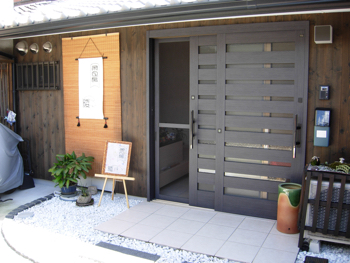 Across the Alley
We were also told that she did not speak any English.
Across the Alley
We were also told that she did not speak any English.
Dawn saw that she was open, but by the time she got ready, the place seemed closed. Later, her sign came out again and Dawn screwed up her courage to go over again and this time I said I would accompany her and bring the laptop. We knocked on the door, said one or two of our survival phrases (though we forgot the most obvious one) and she invited us in. Off with the shoes and on with the slippers that waited by the door and we entered a small shop with two rooms with beautiful clothes hanging on display. We were going to try to communicate with Google translator and it worked, in one direction. I could type in the English and she could read the Japanese that Google produced.
Dawn:
Of course, the plot thickened. I was not accustomed to such linguistic incapability, since many of our recent travels have been in France where I can get along. We showed her the video of "Haiku" so she could get the idea of what we're trying to do here. She "oohed and "ahhed" and seemed to appreciate the work; then I ran back across the alley to get the letter of introduction, in Japanese, that Junko (a lovely woman on staff of Showa Boston) had written on my behalf. We decided to return at a future time; didn't want her to think that we wouldn' t buy anything, but had difficulty establishing when she'd be open. She insisted on calling our Australian landlord, who speaks Japanese, for some translation. I didn't want to bother him, but...
Stephen:
Before this I had been running the computer at our house without the AC adapter, so in the middle of all this we ran out of power. I had to run back to our place to get our power adaptor.
This meant:
I had to take my slippers off and put my shoes on
So I could run across the alley to
Take off my shoes and put a different pair of slippers on
To walk on our tatamis to get the adapter, go back to the door so
I could take my slippers off and put my shoes on
Retrace the seven steps across the alley
Where I took my shoes off, put the first pair of slippers back on again
And then plug in the computer which had suspended in the middle of Haiku.
I had to take my slippers off and put my shoes on
So I could run across the alley to
Take off my shoes and put a different pair of slippers on
To walk on our tatamis to get the adapter, go back to the door so
I could take my slippers off and put my shoes on
Retrace the seven steps across the alley
Where I took my shoes off, put the first pair of slippers back on again
And then plug in the computer which had suspended in the middle of Haiku.
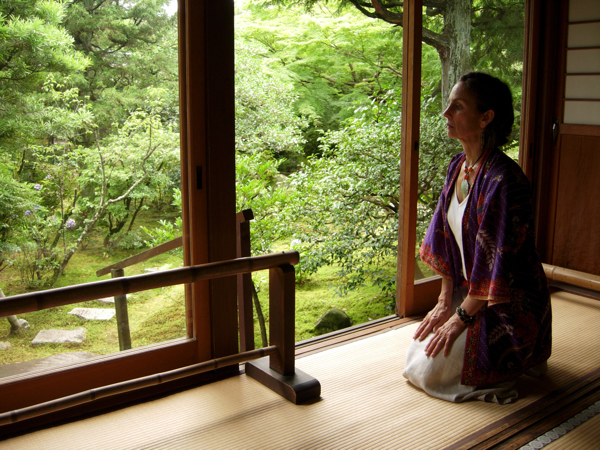
Shoren-in
Dawn:We have visited four temples/gardens so far. Shoren-in Temple brought tears to my eyes: The proportions seemed perfect: of pond, garden, rock, plants, and the framing of the views by the beautifully painted sliding rice paper doors.
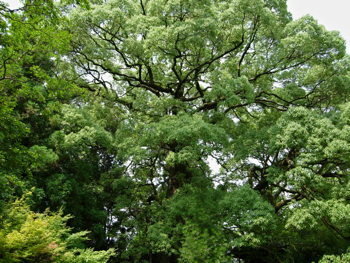
Camphor Tree
There is an 800-year old camphor tree at the entrance! Must run now as we will do Zazen this morning at Shunko-in Temple, spend the day there, stay overnight, and tomorrow we hope to shoot footage for a silent video/movement poem in their garden.
Shunko-in Temple

Map
Stephen:We got back today from our two days of shooting video at the Shunko-in, a Zen Buddhist temple that had been recommended to us by Peter Grilli at the Japan Society of Boston. It was more than shooting. We got there early enough to sit in Meditation with the Abbot. sometimes there are a number of people in attendance, but today there was only the three of us. Afterwards, he showed us to the garden and left us be. There were trees, a dry stream, a bridge, stone lantern, all visible from a porch with closable screens. I set up and Dawn warmed up and sized uo the place.

The Front of Shunko-in
Dawn:Last Monday, we took a bus out to the Myoshin-ji temple complex, the biggest one in Kyoto. Eventually we found Shunkoin Temple, a sub temple in the complex,in time for the 10:40 Zazen session with the young vice-abbot there. We were fortunate to have been introduced to him by letter from Peter Grilli, the head of Boston's Japan Society, and Junko Abuza of Showa Boston. Rev. Takafumi Kawakami welcomes English-speakers (he spent eight years in the States, studying comparative religion in Arizona) and is interested in the relevance of Buddhism to life beyond the temple. He's a great admirer, as I am, of Thich Nhat Hahn's "engaged Buddhism."

Water Barrel in the Rain
Stephen and I had two private sitting sessions with rev. Kawakami which were very useful to both of us, Monday and Tuesday mornings. He showed us where we could work on our video-poems in the garden. It was raining, as it was all last week, and we found some sites that inspired the ideas of "reflection" and "inching along"...both metaphorically apt for our own spiritual paths. We were able to spend the night there so we could re-shoot a bit the next day after having looked at the stuff we shot on Day #1.
It's pretty minimal, that's for sure. Sometimes I wonder how I got to doing these odd little video moments after my life co-directing a dance company and making larger scale, very physical, theatrical dance!...but then today, Sunday, we visited two of the temples with the most austere, "minimal" dry gardens, Ryoan-ji and Daisen-in. The emptiness of space and the asymmetrical placement of rocks in raked gravel invite contemplation, stillness, and an appreciation of minimalism. (The only problem can be the large tour groups that come and go with loud talking, and the recordings that some temples have when one enters the platform viewing space of the dry gardens.) In the last temple we visited, they allowed no cameras which made it a much more pleasant visit. Anyway, I have to keep reminding myself that the environment here invites minimalism in my own art form. I have to stop worrying about not doing enough. In fact, the gardens are so artful in and of themselves, I'm not convinced that I should be doing anything at all in them.
Stephen:
When Dawn went to California last March, I started meditating every day. Just trying to rest my mind on my breathing for a half an hour. I didn't know what I was doing but started to read some of the books on Buddhism and meditating that Dawn had around the house. From about May onward, one of the most frequent distracting thoughts that came into my mind was thinking that in July I was going to be meditating with Buddist monk in a Buddhist Temple in Japan.
Bambu Restaurant
We got back today from our two days of shooting video at the Shunko-in. Tonight we found the map that Rory, our landlord, had left for us that allows us to find a restaurant that he had recommended to us on our first day and now are off to have dinner.We are walking in the rain because this is the rainy season, but it is only five minutes before we find the restaurant. The name out front has a Chinese character (kanji) followed by -boo, so we figured we are in the right place. We slide open the rice paper screen and see a bar for twelve or so people curving around a small kitchen. We are shown to our seats at the bar and given hot wet wash cloths to refresh ourselves before our meal. We are given a menu in English that explains the dishes and also says that while they don't speak English we should feel welcome here. Japanese fusion would be a good beginning as a description of the place.
This is what we ate:
A green salad filled with sashimi (raw fish). It came on a beautiful plate with a small bamboo bowl on one side stacked with a different salad.
A bowl of Bok Choi with scallops. It came with two small bowls, a wooden ladle, and two wooden spoons. I ladled out the food and it was delicious
Then we decided on beef of some kind and a skillet of potatoes with Parmesan (very unjapanese) I used the verb osusume about the beef to ask the waiter to recommend what beef dish, and he served us a plate of raw beef cubes and vegetable and placed a small brazier and bamboo coals between us and placed a hot skillet with melted butter on it. Again I cooked and served.
We accompanied our meal with a couple of Kirins.
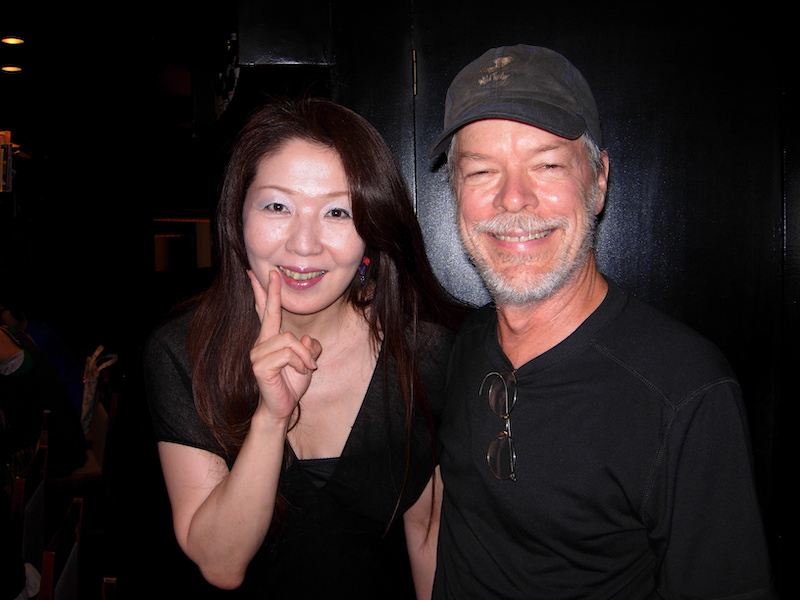
Stephen And Kumiko
Dawn:All the plates and bowls were original and unique pottery or bamboo,hand-carved. The food was amazing, which was great because we hadn't been having such great luck with food. A young woman sitting two seats to Stephen's left smiled at us and showed us a very funny and useful comic book guide to Japanese food for English speakers. She was the first Japanese stranger to smile and actually extend herself to us. As the evening developed, it turns out that she thought Stephen's voice sounded just like Eric Clapton's. She was clearly captivated by Stephen. She did speak some English, and we heard about her time in NYC and London in the fashion industry. Then a gentleman showed up and sat next to her. They conversed, and he said to us in English, "She thinks Japanese men are all male chauvinist pigs!" Perhaps she made this remark because she was shocked that Stephen did the little grilling and serving of the food, and he served me first. In Japan, women always doing the cooking and ordering and serve the men first. Her name was Kumiko.
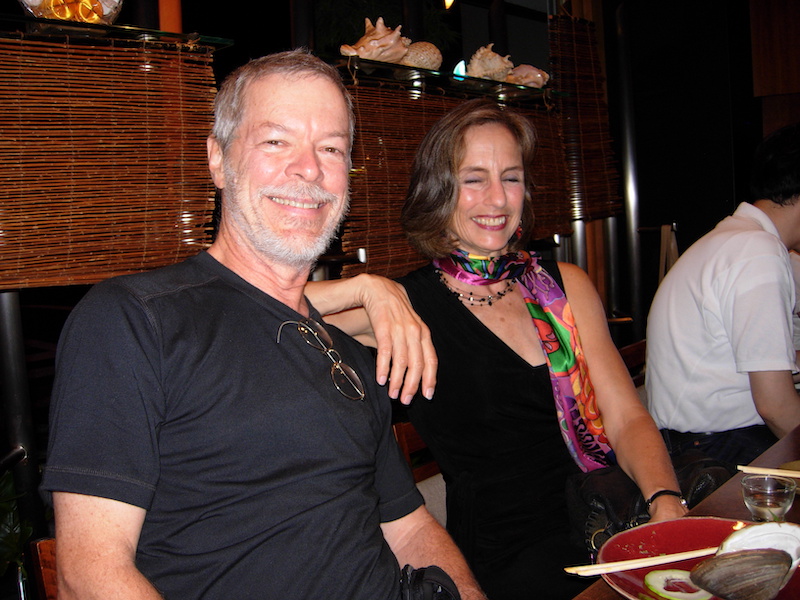
Dawn and Stephen
Stephen:Dawn didn't hear it, but she commented on how beautiful Dawn was. She thought our chopstick work was admirable also. The man and I talked about Zen and sitting and I told him that I was brought to Zen partially through my reading of a book on Quantum Mechanics called "The Wu LI Dancing Masters." He brought out a small notebook and asked me to write down the name of the book.
In the middle of all this, after presenting us with a bamboo shoot full of very good sake and a glass of French wine, the young owner gave us two fans that had been made by his father out of bamboo for which the restaurant is named. We wanted to buy some more because they were so beautiful, so he got on the phone and said that we could have them in five days. So we will return next week to pick up our fans, but certainly will return before then for another meal. On the way out, I nearly got a hug from Kumiko.
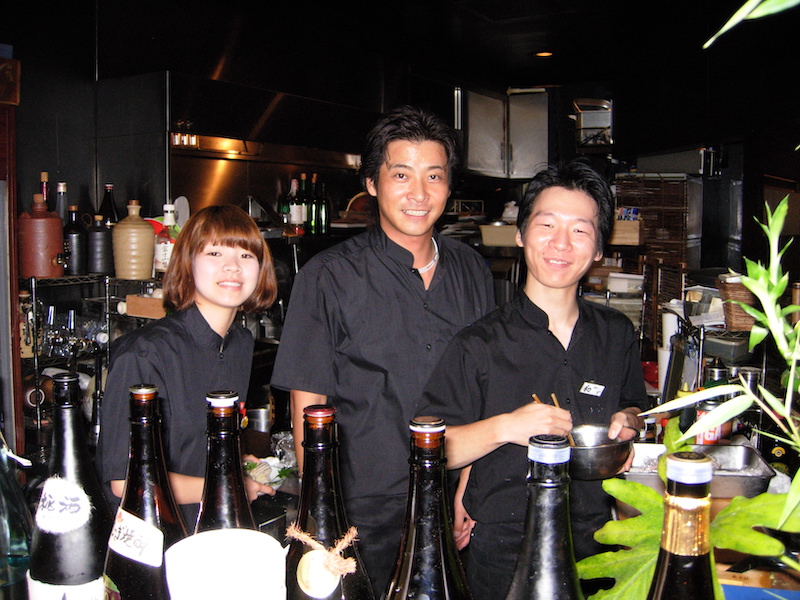
The Staff, a handsome and congenial group
Dawn: Yes, Kumiko was the most effusive (and slightly drunk) Japanese woman I have ever met. She was on the verge of hugging both of us and said. ”I want to see you again.“
Stephen:
We returned to Bamboo Sunday night. We had said we would and we needed to pick up the fans that we ordered. Luck has a lot to do with what happens to you are traveling. More akin to pinball than some strategy game like Go. The first night had been fun and magical. What would happen now? I think it is the Japanese-English food translating picture book than the owner brings out for us when we come in. It seems to attract attention. Before long, the young couple next to us is exclaiming over it and trying out their English.
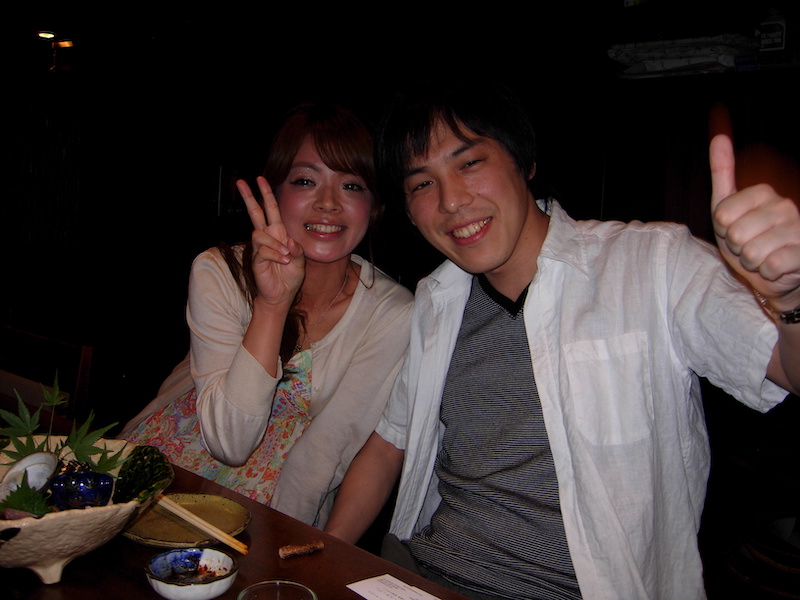
Young Couple we met on the Second Night
Again the conversation, exchange of food and sake. This time picture taking. Toward the end of all this we get a phone call from Kumiko, the owner handed Dawn a portable phone, and she said she was coming right over. The fans have been brought out, and we examined one or two. They are beautiful. When Kumiko comes in, she seems to want to look at more and we get to see more.

Stephen with the Women
She hands the owner the task of getting them wrapped up again. The food is good again. The sake is tasty. In the photo, those tubes are the bamboo containers for the sake. He keeps them in the freezer until they are served. We finally say good bye to all. Our fans are added to our dinner bill, which we pay with a credit card, a rare occurrence in Kyoto which seems to be a cash society.
Dawn:
The young woman in the couple is named Yukiko. We didn't get her boyfriend's name. He took a picture of Stephen surrounded by Kumiko, Yukiko, and myself. It was quite the intergenerational, international bevy of women around him!.
Honen-in
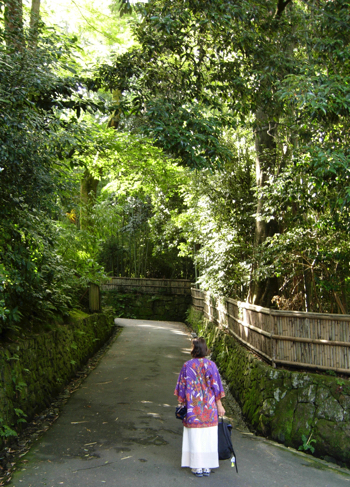
Honen-in Approach
Stephen:
Monday morning, I loaded the camera and tripod, some costumes for Dawn, and we grabbed the bus for Honen-in. We arrived early enough to sit and meditate for 10 minutes or so at their front gate. I would not have been able to do this trip without meditation. I would have gotten way too attached to what I thought we were trying to do, instead of being in the present moment with a slight awareness of your plans. Good thing, because when we finally made our presence known, they did not seem to be aware that we were coming and after some halting discussion in English we decided that we would come back tomorrow... (It was some kind of Holiday that we were not aware of, but, like many many things on this trip, we did not really understand the reasons, we just went along.)

Doorway
I have learned to listen for the "no". You won't hear it spoken, but you can sort of feel it. It might in a pause, or an overornate description of the situation. Here I was trying to arrange video times in the temple gardens. At first I asked if we could come tomorrow morning and when I felt the pause I rephrased the questions to "What would be the best time for you?" (This of course is all in English, perhaps more later about our Japanese) and got the answer that this evening would be best. It was probably terribly impolite of me to ask a question where one of the answers might be "no". To a Japanese person this would be second nature along with the ten or so ways of saying it depending on the difference in the ranks of the people in the conversation.
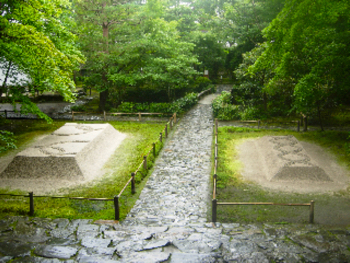
The View From the Doorway
The Next Day
Arriving, we got the sense that that was a function (lunch) around noon and we decided that we would be done by then. Dawn and I practiced making these kind of videos in Boston before we came on this trip and I am very glad we did. The rhythm of deciding on movement, framing, exposure and shooting tests and having Dawn come back and look at takes and reshooting the good parts had been learned in Boston over a number of days shooting in Westwood and the practice made a lot more efficient. We were invited in and escorted to the back garden through the lovely inner courtyard
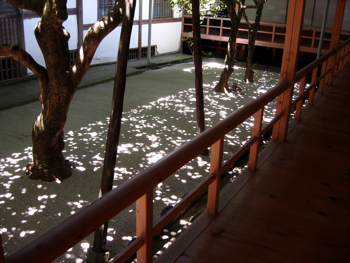
Shadow Patterns in the Inner Courtyard
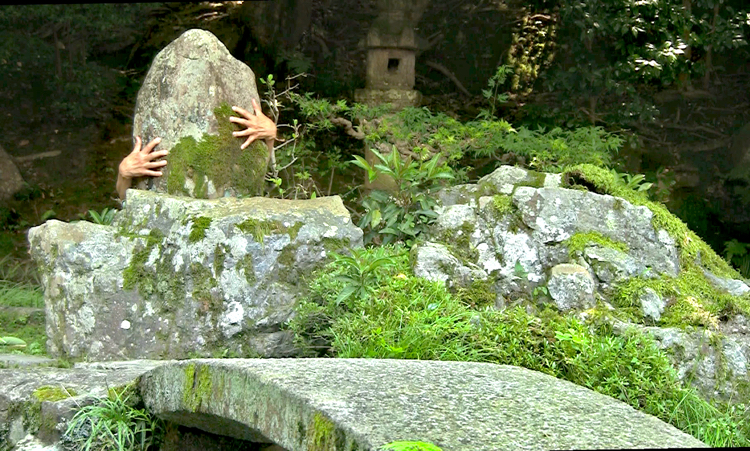

The photos shows the view fron the Monastery. The steps are visible along with the tall triangular rock that Dawn "grabbed" with her hands. She didn't actually touch the moss and lichen, it just had to look like she did. We learned at the last minute that Dawn couldn't step on any plants, so she had to carefully plan how to get to and from the places where she would be.
It made the shooting go a lot slower. After we returned to Boston, I bought a 50' HDMI cable and a small battery powered video monitor for our next shoot, so that Dawn could it take with her to her position so that she could see what we had just shot without having to leave. You can watch this and two other videos that we made at the bottom of this page.
Mount Daimonji

Dawn and Stephen at the Top
Stephen:
Today when we were hiking up one the Eastern mountains, Mt. Daimonji, (maybe a 1000' up) with a view of all of Kyoto, we kept running into these young women hiking up with us. Many of them by themselves or in pairs but all looking out of place from my reference point. There was a Shinto Shrine at the top at which we rested and watched many older people visit. They would kneel, ring the bell, many drop a coin into the box and that would be all. I can't imagine these young hip girls having the same reverence for ancestors, but I am feeling more and more ignorant about the spiritual life of Japan.

Traditional Fashion
Dawn:
Let's talk about "fashion!" The women here in Kyoto are by and large very well dressed. What astonishes me about the young women is that they all wear black leggings or sometimes jeans under frilly, filmy long tops, often very high heels (with ankle wraps now all the rage), long sleeves and/or long gloves; and it is over 90 degrees F. here! People ride bikes with long gloves on. Umbrellas are up whether it's raining or sunny (parapluie ou parasol). More "mature" women all wear long sleeves also, slouchy hats, dressy shoes and often hose. I am dripping in the heat and humidity and am amazed by their clothing coverage. It does say something about the beautiful, porcelain Japanese complexion.
People manage to ride bikes holding an umbrella, carrying groceries, and talking on a cell phone, often with a small child on a seat behind the handle bars. No helmets anywhere. Did anyone ever mention that they drive on the left in Japan? I never knew that. So we figured we should stick to the left on sidewalks as well, but it seems that it's a free-for-all. Bikes ride on sidewalks, streets, bike lanes. People walk in all directions on sidewalks streets, and bike lanes. It's chaos, but I've never seen anyone run in to anyone else. The one thing that is strictly observed is street crossing: only at the pedestrian walks and only when the pedestrian light turns green. People obey this rule.
Arashiyama - The Western Suburb

Our own Kitchen
July 21,Dawn:
Yes, we have moved to the "western suburb" of Arashiyama, into a spectacularly tasteful machiya with a bigger garden and wonderful, Japanese style soaking tub...like our private onsen. The kitchen was beautiful too We took the train out and walked to the place. For the time that we were here, we had no videos to make and people to meet. We would just take it easy and walk around and see the sights.

Our Own Private Onsen

Honestly, today is the first day I felt like I'm "on vacation!"
Tenryuki Temple

Garden
We visited one of the most extensive, magical gardens yet at Tenryuki Temple.
Calm beautiful place. Shaké is the practice of pruning you local garden to be in sync with distant vistas. It is hard to believe that someone climbed those trees to shape them to match the mountains.

Shaké, (plants copying distant hills)
River Walk

A View of the River
We walked along the river for a while. It's drippingly hot, even by the river but we found the shady side, replete with waterfalls and what look like sampan boats for tourists, being poled on the river. From my years of looking at paintings or photos of landscape in Japan and China, this view up the river valley, flanked by hills was a classic Asian scene...to my western visual sensibility.

Fisherman with a Long Pole
This guy is fishing for the small pan fish that are served later that day at the local restaurants.

A Lunch alongside the River
This lunch was a peaceful end to a really hot mid-day hike. Because of the heat of that hike, we've decided to get out early to see temples and gardens, come home and make lunch, rest, write, watch our video work or load photos onto the laptop, and then go out again later. This guys were cooling off with some beers, a lot of beers! Still, they were fun companions at our meal.

Two Guys with the Same Idea
Onsen
Today Stephen was invited by our Aussie friend, also a Stephen, to go to the men's onsen (public bath.) So I've had a few hours to myself and finally was able to do a real yoga practice. It felt wonderful, especially followed by a long soak in the precisely, electronically temperature controlled tub.
Inside Look
Stephen:Hot spring places in Japan take many forms. There are neighborhood places and there are places connected to expensive resorts, but the one that Stephen and I went to was a public one that was kind of a mall. There were young women behind polished wood counters that organized the entrance to the baths, there were lockers downstairs for our shoes, there were lockers upstairs inside the men's area for our clothes, there was a restaurant there where you charged your meal (or half priced beer [Thursday] to your locker number. Once your got your clothes off, you could wander around the tubs.
Outside there was the natural one (no extra heat), there was one that was 1/4 inch deep of flowing water with a rock pillow for your head. You lay on your back (using your towel for modesty) and felt the warm water on your back while you were taking an air bath for your front. The jets were amazing. One place had a jet so strong it had bars so that you could hold yourself in place, another had four jets on your back, they sort of supported you in the water.
They were cold baths too, for people coming out of the sauna or just to take a break from the heat. The sauna had a big screen TV. When we were done, it was time to wash ourselves. (We rinsed off before going in the hot tubs). Each wash station had a stool and a bucket, a faucet that either filled your bucket or went to the hand head shower. You used your towel as a wash cloth and scrubbed yourself sitting down, soap, shampoo, and conditioner provided. Then you rinse the area, wring your towel, and use it to dry yourself. The fans in the locker area finish the drying off. Maybe we spent an hour and a half in there for about $11 each. Seemed like a bargain to me.
Hiking to Otsegi Nembutsu Temple

A Beautiful Bamboo Forest

The Road up to the shrine mostly went through ordinary residential areas.

Fox by the Side of the Road

Rock with Rope
Later, Dawn would try to buy some rope.

Statues in the Shade

A Statuary Family

Dawn Surrounded by Stauary Monks

What seemed to us to be a gentle couple.

Meditation Shrine
Back in Kyoto Center
Gion Matsura

Stephen Richmond, on the Left with Yamamoto-san and Family
Dawn:
It is time to talk about the famous Gion Matsura, a huge July festival, probably the most important in Kyoto. We were invited to join Stephen, our Australian friend who teaches at Gakuen University, and Yamamoto-san from the Consortium. He and his wife came dressed in beautiful yukata and brought their adorable 18-month-old, good-natured daughter.

Gion Festival Friday Night
It has been celebrated for hundreds of years, to ward off evil spirits and keep disease away. Each neighborhood furnishes a mammoth, moving shrine with all kinds of valuable art, Persian rugs, etc. Each is topped with a tree, a dozen flute and xylophone players, everyone in costume. For three nights before the parade, it's all walking around downtown, looking at the yamas and bokos, eating and drinking, wearing traditional yukata (cotton kimonos for both women and men.)

A Cart on Exhibition
Then Saturday is the big parade: The wooden wheels on the big carts must be 6' in diameter; they are pulled by crews of men from each neighborhood. In order to turn these massive things, they have to throw down bamboo slats, wet them down, and do a turning pull. This is repeated three times to get the cart to make a 90-degree turn.

Monks Wait at the First Corner
We actually got ourselves to one of the "turning" corners at around 9:00 a.m. Saturday and waited in the heat for the big event. At 10:30 a.m., the lead float appeared in all its majesty. We were about five rows back, moving forward as people in front of us left, and got to see the whole wheel-turning mechanism and choreography of the maneuver. Pretty spectacular. Tears actually came to my eyes! I didn't know if that was because I was so moved by the re-enactment of this spiritually-based ritual over hundreds of years or if it was just that we had been reading about Gion matsura, planning this trip for so long, and there we were at Karasuma Oike, actually witnessing this ancient celebration!
We took some home movies of the Festival.
DOTS

Ken Furudate and US
Shifting again from old and traditional to modern and somehow familiar, we went back into town last night to watch a rehearsal of a Kyoto-based performance group called /dots/. The Kyoto Art Center is a converted old school and has tons of studios and rehearsal spaces. We walked into an air-conditioned, windowless room to find two dancers doing a mirror improvisation! One was the choreographer. Later we learned that a couple of the other dancers there were essentially auditioning for a new piece; that this was a first rehearsal. It was astonishing how quiet they all were...not chatty like Dance Collective :-) ! Of course, learning that most of them were brand new to the group obviously had something to do with their quietness.
The last 45 minutes of rehearsal was taken up with, what else?, scheduling! Ah, am I glad those days are over! Schedules and money are the two biggest headaches of running a small dance company. Afterwards, we took them out to dinner.

Ken_Furudate Performing "Nocturne", 2019
It's fascinating how movement improv has such universal similarities. They were all beautiful movers, and I could easily identify the structures the choreographer was giving them without understanding Japanese. There were some quirky wonderful moments, especially when one of the men pursued the architecture of the space, using wall, floor, and ceiling in remarkable ways. After awhile, I was craving eye-contact and physical contact (or even a dramatic shift in their spatial proximity) and thinking about Ruth Zaporah's "shifting" of focus, energy, speed, direction. Ah, but it really made me miss dancing, being in a studio with these young movers. Since leaving Dance Collective, my work has become more "movement," less dance Sometimes I just wanna dance!

Natto
One of the young men, Ken, had been instrumental in connecting me with a variety of artists and universities here, so we really wanted to treat him to dinner. It was a fun time, with new local, traditional taste treats. One is "natto," a fermented soybean which is the closest thing they have to cheese, I think. The group was expecting Stephen and me not to like it, but we enjoyed it quite a bit. They are all in their early thirties, maybe a bit younger. In fact, everyone we meet here and interact with is about half our age.
Dogen

Dogen's Shrine
The Place Where Dogen Passed Away
Dogen Zenshi founded the Soto sect of Buddhism. He was born in Kyotoin 1200 and began his Buddhist training on Mount Hiei. Later, he studied Zen under the priest Eisai at Kennin-ji Temple, and in 1223 traveled to China. On returning to Japan, Dogen stopped for a while at Kennin-ji Temple after which he built Kosho-ji Temple in Fukakusa (the temple was later moved to Uji). Continuing teaching and missionary activities, in the later years of his life, Dogen founded Eihei-ji Temple, in what is now Fukui Prefecture. In 1253, Dogen was staying here, at the residence of a disciple. He passed away in Augustat the age of 54.
(From the sign at the site)
Restaurants
Hirano-ya

Entrance

Entrance

The food tastes incredible

and looks great

Stephen Looking Happy

Dawn Looking Happy
Kappa, A Sushi Restaurant for the Masses

For serious, no-frill type eaters

Dawn likes to eat (and the price is right)
We had never seen anything like this before.
Au Bec, a french restaurant
No one Speaks French, but they have been well trained. We just stumbled on the place while out walking. It seemed a bit like home. Paris, that is.

A beautiful Soup

Dawn looks like she wants to jump in
A Nice Fancy Restaurant that we can't remember the name of.

Dawn at the Door

For our Last night out
Taizo-in Temple
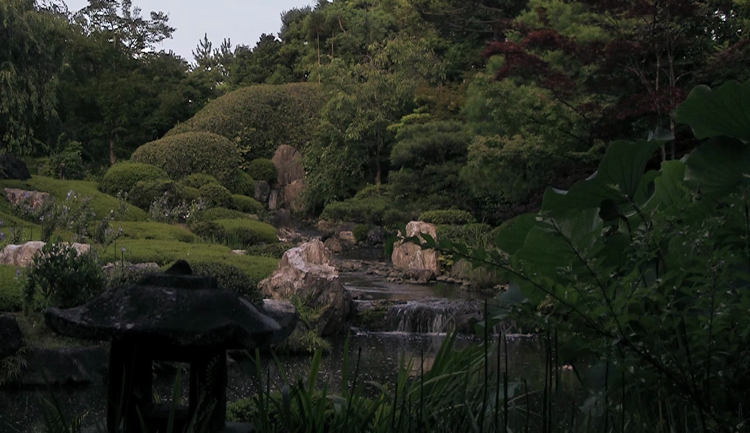
As the Sun Goes Down
People have been generally wonderful here in Japan. Kyoto is reputed to be more conservative and reserved than say Tokyo, but I am amazed when I think of the number of people, all in various positions, who have been so generously helpful to us. For example, at Taizo-in Temple, we met with yet another wonderful young abbot, Daiko Matsuyama, who allowed us to use their incredible waterfall garden during public hours, and invited us to return when the temple was closed for some better shots.
What a privilege to be in that venerable and beautiful space, by ourselves, as the sun was going down. (I do need to ask a Buddhist priest if mosquitoes are considered sentient beings...)
An exchange of emails
Dear Matsuyama-sensei,We are leaving Japan on Thursday and want to thank you again for our time at Taizo-in Temple. Being there alone in the garden last night as the sun was setting was a beautiful experience. It's been a fascinating visit, and I hope our video work will do honor to the locations in which we were privileged to shoot. As mentioned, we were at Shunkoin Temple earlier in our stay and met your friend Takafumi Kawakami-sensei. Both of you are doing wonderful work, connecting Buddhism to contemporary life and welcoming non-Japanese speakers., which we thank your for.
It will be a while before we assemble and edit the video we shot here in Kyoto. When we do, we will send a "private" link to you, Kawakami-san, and Kajita-san (or his wife) at Honen-in so that you can approve the work before we show it to the public. Also, you can then let us know how you would like to be acknowledged in the credits.
Domo arigatou gazaimasu. I hope our paths will cross again.
Best regards,
Dawn & Stephen
Dawn & Stephen Sensei
Thank you very much for coming to the temple the other day. I feel very happy to hear that you liked here. I hope you have completed your job and look forward to seeing your masterpiece on the website.
Thank you again and take care of yourself.
Best regards ~~~~~~~~~~~
Taizoin Zen Buddhism Temple Yokoso!
Japan Ambassador Rev. Daiko Matsuyama
35 Myoshinji-cho Hanazono Ukyo-Ward
Kyoto city, 616-8035 JAPAN
info@taizoin.com
Walking Around In and Out of Town

Ohara, A Mountain Town

Murin, a Twentieth Century Design

Canal
On our way home to the first apartment, This lovely street speaks for all of beautiful Kyoto.
The Golden and Silver Temples

Ginkakuji Temple (Silver)

A Weeding Meditation
The monk on the right carefully removed each weed with attention. He did nothing that was not needed and left nothing out. Years later, I was reminded of him by the driving of a young noviate at the Plum Village Monastery in France. She picked us up at the train station and drove us. She did everything that she was supposed to. She looked both ways at the intersections, she drove the proper speed. She didn't overdo or underdo anything. Everything took the right amount of time. So it all felt just right and easy.
I Think He is a Monk.

Golden Temple, across the Pond

Golden Temple, hiding behind a tree
Our last place in Kyoto, see Website

Living Room
This apartment was the biggest and fanciest but felt a little heavy, more "Western". We liked the hole under the living room table. We could sit easily at the low Japanese style table but look like the Japanese. It was great for our backs. It was very large compared to where we had been before.

Kitchen
The kitchen would have been great for entertaining or for making meals that we were not capable of shopping for. The apartment was right in the thick of things. The Gion Festival, the week before, would have been in our laps. This was a rental place for Western businessmen. We missed the charm of our other two places.
For example, I think we were out shopping for something as simple as soy sauce. The bottles all looked the same, but had nothing we could see that told us is was soy soy. Finally, we grabbed a bottle and decided this is it. We were put out of our misery by a woman, who most have been watching us, who then walked by and said, "That's not soy sauce." I sure that her kindness broke a lot of rules of politeness so she didn't even stop to spare us any more embarrassment.
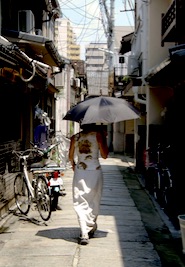
Dawn in the Alley between our House
and the Dogen Shrine
Favors or requests are taken very seriously here. We asked our host, Miho, the sister of the owner of Maeniiya, of our last machiya in Kyoto where we might buy some rope that we see tied to tori and wrapped around rocks. Dawn saw this kind of wrapping on the way to the shrine. She said that there is lots in the country, but it is not a city item, but a few hours later she emailed us a Google map with a store on it that would sell it to us. She also offered to take us there. We of course refused as it seemed beyond the call of duty. Here, every request gets a response. If you look at the videos below, you will see that we never did use any rope.
The Three Videos That We Made
Honen-in
Shunko-in
Taizo-in
concept and performance - Dawn Kramer
video and editing - Stephen Buck
Thank you:
Rev. Shinsho Kajita, Honen-in Temple
Rev. Takafumi Kawakami, Shunko-in Temple
Rev. Daiko Matsuyama, Taizo-in Temple
Junko Shiota Abuzza, Naohiro Yamamoto, Stephen Richmond,
Akiko Yamakazi, Kiranada Sterling Benjamin, Japan Society of Boston,
The Massachusetts College of Art and Design Foundation,
Colleges of the Fenway Consortium
This visit and video-making would not have happened if it weren't for:
Junko-san's (Showa, Boston) wonderful letter of introduction, written in Japanese,
Yamamoto-san's phone calls (He's from the Kyoto Consortium of Colleges)
Yamazaki-san from the Kyoto city government (She met us at the gate of the temple yesterday)
the 'stimulus" grant from MassArt and much more Plus many others who have helped us, like:
Kiranada who wrote a letter of introduction to Honen-in Temple
Stephen Richmond
Ken Furudate, from DOTS
Koichi Nishi
Peter Grilli (Japan Society, Boston)
and the list goes on...
